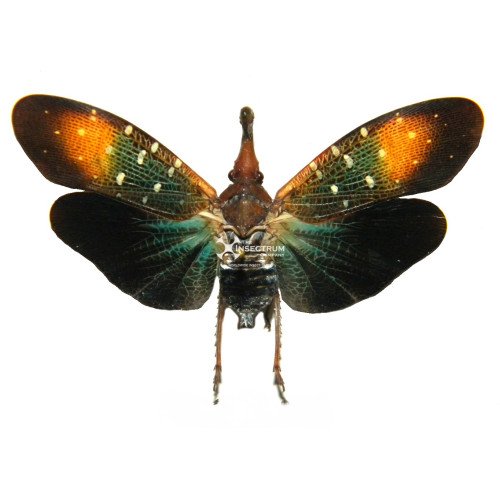
Pyrops whiteheadi gunjii, commonly referred to as the Gunjii Lanternfly, is a striking species of planthopper within the family Fulgoridae. This insect is characterized by its vivid coloration and intricate wing patterns. Its forewings display a mix of yellow, green, and white speckles, while the hindwings feature a gradient of blue near the abdomen and black borders, creating a visually captivating appearance . Like other members of the genus *Pyrops*, it possesses an elongated, snout-like projection on its head, though this structure is not bioluminescent despite the "lanternfly" moniker . Historically classified as a subspecies of *Pyrops whiteheadi*, recent taxonomic revisions have elevated *P. gunjii* to full species status, distinguishing it from its Bornean relative *P. whiteheadi* .
Ecologically, *P. gunjii* inhabits tropical rainforests, where it feeds on plant sap using specialized piercing-sucking mouthparts. While specific host plants remain undocumented, its behavior aligns with other *Pyrops* species, which excrete excess sugary honeydew, often attracting mutualistic relationships with ants or other insects . The species is prized by collectors for its aesthetic appeal, with specimens frequently sold in entomological markets or displayed in framed arrangements . Despite its popularity, detailed biological data—such as reproductive habits or population trends—are limited, highlighting the need for further research into this enigmatic insect’s ecology and conservation status .
We firmly support the sustainable tropical butterfly collections as long as they take care of the conservation of the rainforest where they fly and the development of responsible conscious trading. This allows us to support local ranching farms with ethically sourced material and help at the same time collectors and enthusiasts to contribute to understanding and treasuring those species.
Please take into consideration that the specimen that you will receive may slightly differ in size, shape or colour from the picture shown as you are purchasing a natural product.
All our items are carefully delivered to prevent damages on transport, papered items are packaged in glassine envelopes specifying capture/breeding data and location available. CITES certificate will be provided in the specimens required.
HOW WE GRADE OUR LISTINGS (SPECIMENS)
As Insect specimens are natural products, some are bred and some others caught in wild, the quality can vary greatly.
The guide below explains the grading used for specimens in our listings.
A1 No visible imperfections, both antennas, no tearing, scratches or missing part of the wings (or as perfect as you could expect from wild caught specimens), with exception of some leg damage.
A1- Very minor damage, normally restricted to antenna damage or antennae attached separately in the envelope.
A- These specimens have minor damage, such as antenna damage, or minor flight wear such as small scratches, minor sale damage, some minor fraying/chipping around the edges of the wings.
A2 More significant damage, such as major flight wear, small rips, small pieces missing from the wings, damage to the thorax or abdomen.
B or Second Grade These specimens have similar damage to A2 specimens, but to a more significant degree. Usually used as parts replacement or art work material
| SPECIMEN | |
|---|---|
| Country | indonesia |
| Locality | East Java |
| Collection type | Wild collected |
| Bio-zone | Indomalayan |